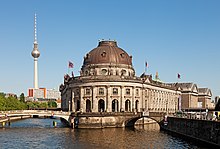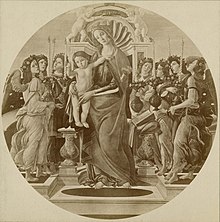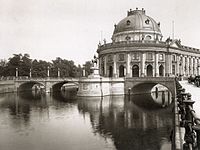Bode Museum
 | |
 | |
Former name | Kaiser-Friedrich-Museum |
|---|---|
| Established | 1904 |
| Location | Museum Island,Berlin |
| Coordinates | 52°31′19″N13°23′41″E/ 52.52194°N 13.39472°E |
| Type | Art museum |
| Website | smb.museum |
| Part of | Museumsinsel (Museum Island), Berlin |
| Criteria | Cultural: ii, iv |
| Reference | 896 |
| Inscription | 1999 (23rdSession) |
| Area | 8.6 ha (21 acres) |
| Buffer zone | 22.5 ha (56 acres) |
TheBode Museum,formerly called theKaiser-Friedrich-Museum(Emperor Frederick Museum), is alisted buildingon theMuseum Islandin thehistoric centreofBerlin.It was built from 1898 to 1904 by order of German EmperorWilliam IIaccording to plans byErnst von IhneinBaroque Revival style.The building's front square featured a memorial to German EmperorFrederick III,which was destroyed by the East German authorities.[1]Currently, the Bode-Museum is home to the Skulpturensammlung, the Museum für Byzantinische Kunst and the Münzkabinett (sculpture, coins and medals, and Byzantine art).[2]As part of the Museum Island complex, the Bode-Museum was inscribed on theUNESCOWorld Heritage Listin 1999 because of its outstanding architecture and testimony to the development of museums as a cultural phenomenon in the late 19th and early 20th centuries.[3]
History and collections[edit]
Originally called the Kaiser-Friedrich-Museum afterEmperor Frederick III,the museum was renamed in honor of its first curator,Wilhelm von Bode,in 1956.[citation needed]
DuringWorld War II,portions of the collection were stored in an antiaircraft tower called theFlakturm Friedrichshainfor safe keeping. In May 1945, several fires destroyed some of the collections. In total, more than 400 paintings and about 300 sculptures were missing due to looting during the fire or destroyed in the fire itself.[4]
Closed for repairs since 1997, the museum was reopened on 18 October 2006, after a €156 million refurbishment.[5]True to the ethos of its founding director, Wilhelm von Bode, who believed in mixing art collections,[6]it is now the home for a collection of sculptures,Byzantine art,andcoinsand medals.[7]The presentation of the collections is both geographic and chronological, with the Byzantine and Gothic art of northern and southern Europe displayed separately on the museum's first floor and a similar regional division of Renaissance and Baroque art on its second floor.[6]

The sculpture collection displays artwork of theChristian Orient(with an emphasis onCopticEgypt), sculptures fromByzantiumandRavenna,sculptures of theMiddle Ages,theItalianGothic,and the earlyRenaissance,including the controversialFloraattributed by Bode toLeonardo da Vincibut now widely argued to be a 19th-century work. Late German Gothic works are also represented byTilman Riemenschneider,the south German Renaissance, and PrussianBaroque artup to the 18th century. In the future selected works of theGemäldegaleriewill be integrated into the sculpture collection. This is reminiscent of William von Bode's concept of "style rooms", in which sculptures, paintings, and crafts are viewed together, as was usual in upper middle-class private collections.
TheMünzkabinett( "coin cabinet" ) is one of the world's largestnumismaticcollections. Its range spans from the beginning ofmintingin the 7th century BC inAsia Minorup to the present day. With approximately 500,000 items, the collection is a unique archive for historical research, while its medal collection also makes it an important art exhibition.[citation needed]
Writing inThe Financial Timeson the occasion on the museum's reopening in 2006,Neil MacGregor,director of theBritish Museum,hailed "the most comprehensive display of European sculpture anywhere." He added: "It is no exaggeration to say that in the new Bode Museum, Europe will be able for the first time to read its history — aesthetic and religious, intellectual and political — in a three-dimensional form."[6]
Multaka: Museum as Meeting Point[edit]
In 2015, the museum started a new project for Arabic- and Persian-speaking refugees and other Muslim visitors titled "Multaka- Museum as Meeting Point ". This intercultural project organizes guided tours for refugees and migrants designed and offered for free by specially trained guides. The visitor-centered discussions with migrants in their language are focused on thehistorical origin and history of acquisitionof cultural objects, including the visitors' own understanding of their country'scultural heritage.In 2019 the four founding museums in Berlin joined six similar museums in the United Kingdom, Italy, Greece and Switzerland, creating the international Multaka network.[8]
Canadian gold coin theft[edit]

On 27 March 2017, a solid gold coin called theBig Maple Leaf,issued by theRoyal Canadian Mintin 2007 as a commemorative piece, was stolen from the museum.[9][10]The coin, at 50 cm in diameter and 2.8 cm in thickness, is made of 24-karat gold and is worth around €3.7 million.[11]A ladder was found on the train tracks nearby, leading German police to speculate that the thief entered the building by breaking open a window in the back of the museum next to the railway tracks.[9][11]
The thieves were later found to be 21 and 23-year-old cousins Ahmed and Wissam Remmo, along with their friend, Denis W.[12]Police do not expect to ever recover the coin, as the presence of gold dust leads them to believe the culprits had melted it down. Ahmed's brother Wayci was also charged, but later acquitted.
See also[edit]
Gallery[edit]
-
At night
-
The entrance hall
-
The cupola
-
Byzantine collection
-
Trecento room
-
Museum IslandwithPergamon Museumand Bode Museum (1951)
-
Bode-Museum, Berlin von der Spree.
-
View from the Bode Museum bridge on to the river
-
The Bode Museum, part of the ensemble of Berlin Museums located on the UNESCO listed Museum Island
References[edit]
- ^Bodemuseum (Kaiser-Friedrich-Museum)(in German) Landesdenkmalamt BerlinArchived18 July 2020 at theWayback Machine
- ^"Staatliche Museen zu Berlin: Home".Staatliche Museen zu Berlin.Retrieved29 January2023.
- ^"Museumsinsel (Museum Island), Berlin".UNESCO World Heritage Centre.United Nations Educational Scientific and Cultural Organization.Retrieved30 July2022.
- ^"Beauty, Fire, & Memory: Lost Art of the Kaiser-Friedrich-Museum".National Gallery of Art Department of Image Collections.Archivedfrom the original on 24 October 2020.Retrieved19 November2021.
- ^"Teuer, billig, im Plan: Berliner Kulturbauten und was sie kosten".Der Tagesspiegel.17 October 2013.
- ^abcRiding, Alan (27 November 2006)."German Museums Move Closer to Reunification".The New York Times.ISSN0362-4331.Retrieved29 January2023.
- ^"Sculpture Collection and Museum of Byzantine Art".Staatliche Museen zu Berlin.Archived fromthe originalon 15 September 2012.
- ^"Multaka".amir project(in Italian).Retrieved20 May2024.
- ^ab"Solid gold coin worth $4m stolen from Berlin museum".BBC News.27 March 2017.Retrieved27 March2017.
- ^Dowling, Tim (28 March 2017)."Forging pound coins? That's not a crime – it's a job".the Guardian.Retrieved10 April2022.
- ^abHall, Melanie (28 March 2017)."Giant gold coin worth almost €4 million stolen from Berlin museum in dawn heist".The Telegraph.Retrieved27 March2017.
- ^Dafoe, Taylor (21 February 2020)."The Bumbling Thieves Who Stole an Enormous $4.3 Million Gold Coin From a Berlin Museum—and Probably Melted It Down—Are Heading to Prison".Artnet News.
External links[edit]
- Official website(in English and German)
- Sculpture Collection and Museum of Byzantine Art
- Virtual Tour Through 35 Rooms (Sculpture Collection and Byzantine Art)
- Numismatic Collection
- Virtual Tour Through Numismatic Collection (with Gateway to Online Catalogue)Archived6 September 2015 at theWayback Machine
- Art museums and galleries in Berlin
- Museum Island
- Numismatic museums in Germany
- Staatliche Museen zu Berlin
- History museums in Germany
- Heritage sites in Berlin
- Art museums and galleries established in 1904
- 1904 establishments in Germany
- Baroque Revival architecture in Germany
- Museums established in 1904
- Frederick III, German Emperor
- Wilhelm II










